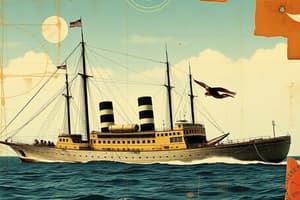Podcast
Questions and Answers
What should a vessel do when it hears a fog signal forward of the beam?
What should a vessel do when it hears a fog signal forward of the beam?
- Make a substantial course alteration
- Reduce speed to reply with its own fog signal (correct)
- Attempt to make radio contact
- Go full astern
In the event of a collision where ships are locked together, what action should not always be taken?
In the event of a collision where ships are locked together, what action should not always be taken?
- Steerage way
- Sound tanks
- Attempt to make radio contact
- Make a substantial course alteration (correct)
In a traffic separation scheme, which vessels are prohibited from impeding the passage of other vessels?
In a traffic separation scheme, which vessels are prohibited from impeding the passage of other vessels?
- A power-driven vessel following a traffic lane
- A vessel engaged in fishing
- A sailing vessel of less than 20 meters in length (correct)
- A vessel crossing the traffic separation scheme
What action is required if your ship is in collision in the waters of a foreign nation?
What action is required if your ship is in collision in the waters of a foreign nation?
When seeing lights right ahead at medium range in open waters, what should be done?
When seeing lights right ahead at medium range in open waters, what should be done?
Which action is NOT part of the responsibility of the MASTER in case of a collision?
Which action is NOT part of the responsibility of the MASTER in case of a collision?
According to Collision Regulations, what provision can be made by the Government of any State between vessels?
According to Collision Regulations, what provision can be made by the Government of any State between vessels?
'Rule 19' requires a vessel hearing a fog signal forward of the beam to:
'Rule 19' requires a vessel hearing a fog signal forward of the beam to:
What is the required action when two black balls are seen in a vertical line on another vessel?
What is the required action when two black balls are seen in a vertical line on another vessel?
When should a vessel avoid impeding the safe passage of other ships in a traffic separation scheme?
When should a vessel avoid impeding the safe passage of other ships in a traffic separation scheme?
Flashcards
What should you do in a fog?
What should you do in a fog?
To signal presence and reduce speed when within hearing range of another vessel's fog signal.
When two ships are in a ‘locked’ collision, what should not always be done?
When two ships are in a ‘locked’ collision, what should not always be done?
In a collision, avoid drastic changes to your course.
Who is prohibited from impeding traffic in a traffic separation scheme?
Who is prohibited from impeding traffic in a traffic separation scheme?
Smaller vessels are prohibited from slowing down or obstructing larger vessels within a designated traffic lane.
What action should be taken in the event of a collision in foreign waters?
What action should be taken in the event of a collision in foreign waters?
Signup and view all the flashcards
When seeing lights right ahead at medium range, what should be done?
When seeing lights right ahead at medium range, what should be done?
Signup and view all the flashcards
What is NOT the responsibility of the MASTER in case of a collision?
What is NOT the responsibility of the MASTER in case of a collision?
Signup and view all the flashcards
What provision can be made by any State regarding vessels?
What provision can be made by any State regarding vessels?
Signup and view all the flashcards
What does Rule 19 require of a vessel when it hears a fog signal?
What does Rule 19 require of a vessel when it hears a fog signal?
Signup and view all the flashcards
What is the required action when seeing two black balls?
What is the required action when seeing two black balls?
Signup and view all the flashcards
When should a vessel avoid impeding safe passage in a traffic separation scheme?
When should a vessel avoid impeding safe passage in a traffic separation scheme?
Signup and view all the flashcards
Study Notes
Whistle Signals
- Whistle signals: 5 or more short blasts, rapid blasts, or a combination of both to signal warning or danger
- Sound pressure level of a whistle: at least 130 dB at 1 meter
- Audibility range of a whistle: at least 2 miles in still air and still water
COLREGS (International Regulations for Preventing Collisions at Sea)
- Annex I: vertical separation of masthead lights on a power-driven vessel
- Annex III: whistle signals, sound pressure levels, and audibility ranges
- Annex IV: firing of a gun at 1-minute intervals indicates a vessel is in distress
Lights and Shapes
- Sidelights of a vessel 20 meters or more in length: fitted with screens
- Minimum intensity of sidelights: 1° and 3° outside the prescribed sector
- Vessels engaged in fishing with purse seine gears: exhibit two yellow lights in a vertical line
Navigation and Collision Prevention
- Good seamanship: considering dangers of navigation and collision, and special circumstances
- "Underway" means a vessel is not at anchor or made fast to the shore
- Safe speed: related to prevailing circumstances and conditions
Traffic Separation Schemes
- Vessels engaged in fishing shall not impede the passage of a power-driven vessel following a traffic lane
- Vessels of less than 20 meters in length or sailing vessels shall not impede the safe passage of a vessel following a traffic lane
Studying That Suits You
Use AI to generate personalized quizzes and flashcards to suit your learning preferences.




